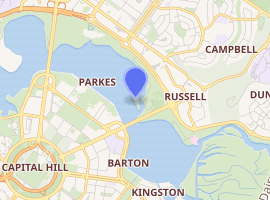National Carillon
The National Carillon is a large carillon situated on Aspen Island in Lake Burley Griffin, central Canberra, in the Australian Capital Territory, Australia. The carillon is managed and maintained by the National Capital Authority on behalf of the Commonwealth of Australia. It has 57 bells, ranging nearly 5 octaves from the 6,108kg bass bell in F# to the 8kg treble bell in D.
| National Carillon | |
|---|---|
 National Carillon in 2016 | |

| |
| General information | |
| Status | Complete |
| Type | Carillon |
| Architectural style | Brutalist |
| Location | Aspen Island, Lake Burley Griffin, Canberra, Australian Capital Territory |
| Country | Australia |
| Coordinates | 35°17′55″S 149°08′30″E |
| Inaugurated | 26 April 1970 by Elizabeth II |
| Renovated | 2004 |
| Owner | Commonwealth of Australia |
| Landlord | National Capital Authority |
| Height | 50 metres (164 ft) |
| Technical details | |
| Material | Concrete |
| Design and construction | |
| Architecture firm | Cameron Chisholm Nicol |
| Other designers | John Taylor & Co (bells) |
| Official name | Carillon, Wendouree Dr, Parkes, ACT, Australia |
| Type | Listed place |
| Criteria | D. and E. |
| Designated | 22 June 2004 |
| Reference no. | 105346 |
| References | |
| [1] | |
History
The carillon was a gift from the British Government to the people of Australia to commemorate the 50th anniversary of the national capital, Canberra. The structure was the subject of a limited competition between three selected Australian architects and three selected British architects. Assessors of the competition were Lord Holford, Sir Donald Gibson and Sir John Overall (Chairman of the National Capital Development Commission). The winners were the Western Australian firm of Cameron Chisholm Nicol. The Carillon was designed in 1967, built during 1969 and completed in 1970. The three columns of the design symbolise the British and Australian Governments and the City of Canberra. Queen Elizabeth II officially opened the National Carillon on 26 April 1970. The Carillon has a symbolic value in the link between Britain and Australia. It also has some historic value for its association with the commemoration of the 50th Jubilee of the founding of Canberra. The tower stands 50 metres (160 ft) tall. The concept was developed in 1968 by Don Ho, an architect at Cameron Chisholm Nicol. The carillon bells and mechanism were designed and constructed by John Taylor & Co of Loughborough.[1][2]
The Carillon is a good example of the late twentieth century Brutalist style. Its use of strong shapes which are boldly composed, the diagonal line of the roofs, large areas of blank wall, use of precast non load-bearing wall panels and strongly vertical windows and openings are all features of this style.[1]
2019 Upgrade
In 2019 the carillon was upgraded with a new clavier, a fully replaced transmission and the addition of 2 new bells to add the lowest semitone and a new highest bell. The new lowest semitone bell was called the Ngunnawal bell, in recognition of the first peoples of the Canberra region. This bell weighs just over 5 tonnes and sounds the note G. The other bell added was a new lightest bell to extend the rage of the instrument to nearly 5 octaves. This work was carried out by John Taylor & Co.
The work was delayed by the onset of the Coronavirus disease 2019 pandemic.
Characteristics
Carillons must have at least 23 bells to be considered as such, and the National Carillon has 57. It was initially installed with 53, and increased to 55 during refurbishments in 2003-4.[3] Each bell weighs between seven kilograms (fifteen pounds) and six tonnes (six point six short tons). The bells span four and a half octaves chromatically. John Douglas Gordon, after whom the Aspen Island footbridge is now named, played the inaugural recital.[4]
The carillon features moderate-size function facilities for small gatherings offering views over Lake Burley Griffin and central Canberra.
The carillon is in regular use, chiming every quarter-hour and playing a short tune on the hour along with tours and recitals on many days. For example, there is usually a recital of carols on Christmas Eve each year with music being played for around an hour at dusk. The best place to listen to the carillon is suggested to be within 100 metres (330 ft) of the building though the sound can usually be heard much further away in the Parliamentary Triangle, Kingston and Civic.
Links to memorials
The adjacent National Workers Memorial was constructed with the idea that people attending would hear the sound of bells from the carillon, which would assist them in remembering their loved ones.
Gallery
_-_bells.jpg) National Carillon bells
National Carillon bells.jpg) Hot air balloon over Lake Burley Griffin, showing the National Carillon
Hot air balloon over Lake Burley Griffin, showing the National Carillon The Carillon keyboard
The Carillon keyboard.jpg) Carillon at sunset, 2011
Carillon at sunset, 2011
See also
References
- "Carillon, Wendouree Dr, Parkes, ACT, Australia (Place ID 105346)". Australian Heritage Database. Department of the Environment. 22 June 2004. Retrieved 18 May 2020.
- "National Carillon". Monument Australia. n.d. Retrieved 18 May 2020.
- "National Carillon & Aspen Island Heritage Management Plan, Draft 12" (PDF). National Capital Authority. p. 41. Archived from the original (PDF) on 2 June 2011.
- "National Carillon". National Capital Authority. n.d. Retrieved 18 May 2020.
Attribution
![]()
Bibliography
- Canberra's Carillon. Department of Territories. Australian Government. n.d.
- Garnett, Rodney; Hyndes, Danielle (1992). The heritage of the Australian Capital Territory. Canberra: National Trust of Australia (ACT). p. 108.
- Register of Significant Twentieth Century Architecture. Citation. Royal Australian Institute of Architects (ACT Chapter). n.d.
- Sparke, Eric (1988). Canberra: 1958-1980. Canberra: Australian Government Publishing Service.
- Information gleaned from file as part of upgrade. August 1995.
External links
![]()